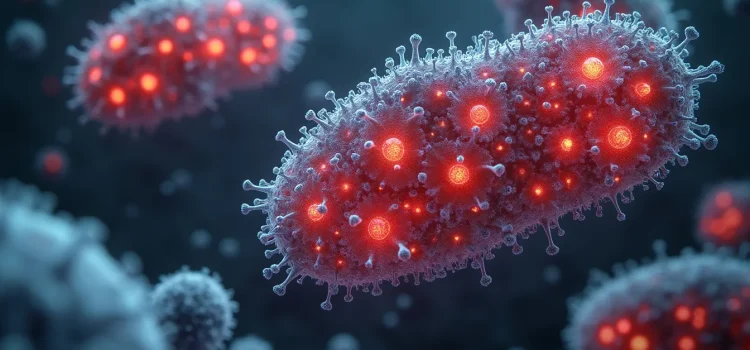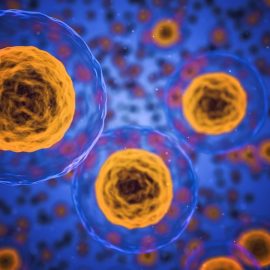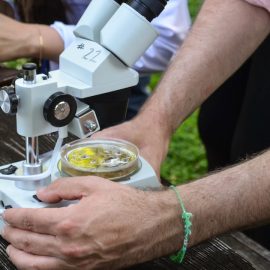

This article is an excerpt from the Shortform book guide to "The Code Breaker" by Walter Isaacson. Shortform has the world's best summaries and analyses of books you should be reading.
Like this article? Sign up for a free trial here.
What is CRISPR, and how does it work? What if we could use nature’s defense mechanisms to revolutionize medicine?
CRISPR, a natural biological feature found in some microorganisms, has become a powerful tool for genetic modification. Walter Isaacson’s book The Code Breaker explores its scientific background, discovery in nature, and how it functions as an antiviral defense mechanism in bacteria.
Keep reading to learn what CRISPR is and how it works.
The Biological Process Known as CRISPR
What is CRISPR, and how does it work? CRISPR is short for “clustered regularly interspaced short palindromic repeats,” which refers to a repetitive pattern inside the DNA of some types of micro-organisms. It’s a natural biological feature that scientists discovered and used to facilitate gene editing. We’ll give some scientific background that will help you understand CRISPR. Then, we’ll explain how scientists discovered CRISPR in nature and figured out how it works.
Scientific Background
To help you understand CRISPR, Isaacson provides some scientific background information on three basic biological units: genes, DNA (deoxyribonucleic acid), and RNA (ribonucleic acid). Let’s explore those now.
Genes
Isaacson traces CRISPR’s development back to the proto-genetic theories of scientists Charles Darwin and Gregor Mendel in the mid-1800s. Darwin, who proposed the theory of evolution, argued that certain traits were passed down through generations via a process called natural selection. He thought reproduction occurred when tiny parts of both parents’ bodies migrated into the egg and sperm and then blended in the offspring, but this wasn’t quite correct. Mendel then showed that some traits are dominant (more likely to appear) and others are recessive (less likely to appear). These findings led other scientists to hypothesize about the existence of genes—molecular units containing inheritable traits.
DNA
Later, scientists discovered that genes are segments of DNA (deoxyribonucleic acid), a molecule inside which inheritable traits are encoded. In the 1950s, scientists Rosalind Franklin, James Watson, and Francis Crick showed that DNA has a double helix structure that can be split in two and replicated—this process is what enables genes to be inherited. Isaacson notes that Franklin’s contributions to the discovery of DNA’s structure were undervalued because of her gender (Watson and Crick were men and have received greater historical recognition).
(Shortform note: All living organisms have DNA. DNA is made of substances called nucleotides, and each nucleotide is composed of phosphate, sugar, and a nitrogenous base. There are four types of nitrogenous bases; different combinations of these result in different instructions for the composition of an organism. For example, your nucleotides are arranged differently than a bird’s, which is why you’re so different from birds. In fact, your nucleotides are arranged differently than anyone else’s—even if you have an identical twin—which is why you’re not exactly like anybody.)
According to Isaacson, experts long believed that they could begin to solve inheritable medical problems by studying DNA and identifying problematic genes. This led to the formation of the Human Genome Project (an international effort to catalog human DNA) in the 1990s. But Isaacson explains that this approach was lacking—DNA only tells you which genes are present in a cell, not how to alter them.
(Shortform note: The Human Genome Project was devoted to DNA sequencing—the process of determining the order of nucleotides in a strand of DNA. While the Human Genome Project didn’t teach scientists how to alter problematic genes, it did help scientists establish links between certain genes and certain diseases and disease immunities. With those genes identified, it’ll be easier for scientists in the future to create precisely targeted gene therapies.)
RNA
Alongside DNA, cells contain a molecule called RNA (ribonucleic acid). Until the 1980s, scientists only knew about one type of RNA: messenger RNA (mRNA), which copies and transmits genetic information. Then, scientists discovered another type of RNA called ribozymes, which act like enzymes (a kind of protein that catalyzes chemical reactions). They also found out that ribozymes could help RNA molecules splice themselves—that is, the molecules could make copies of themselves that automatically cut out certain unnecessary sections. Isaacson explains that this discovery opened the door for scientists like Jennifer Doudna to research how RNA could be used to alter genes.
(Shortform note: mRNA was discovered by two French scientists—François Gros and François Jacob—at the same time (1961). The 1982 discovery of self-splicing RNA (which is more common than previously believed) led researchers to study RNA’s potential for gene editing, but note that self-splicing RNA and ribozymes are not involved in traditional CRISPR gene editing technology. However, scientists have recently begun exploring ribozymes’ potential applications with regard to CRISPR. For example, one 2022 study showed how ribozymes could make CRISPR target specific genes in a more specific way than previous methods.)
| The (Often Winding) Road Toward Recognition for Genetic Scientists A central theme in The Code Breaker is recognition—which scientists are acclaimed for their discoveries and why? Let’s discuss discrepancies in science historians’ recognition of early genetic scientists. Isaacson says Darwin and Mendel should receive partial credit for the discovery of genes. In The Gene, Siddhartha Mukherjee explains how Mendel improved upon Darwin’s understanding of heredity: Darwin mistakenly believed that traits were passed down in blendable particles called gemmules. Mendel disproved this theory by showing that some traits (like the color of flowers) are passed down completely intact, which meant that single traits must be individually packaged in encasements he called “factors.” (We now call these chromosomes.) While Mendel didn’t receive any recognition for his proto-genetic research until the 20th century, Darwin’s work was widely recognized as impactful as soon as he published On the Origin of Species. Another drama played out in the 1950s. Isaacson explains that Franklin’s role in the discovery of DNA’s structure is often underplayed because she was a woman, while Watson and Crick (both men) remain in the limelight. In 2023, Watson and Crick’s biographers revealed just how much Franklin has been undervalued: Many believe that Franklin was the first to discover DNA’s structure but didn’t understand its significance, and that Watson and Crick deserve more credit than she did because they made important inferences based on her discovery (albeit, without her permission). However, primary documents reveal that Franklin did understand the significance of her discovery and should get equal recognition. |
CRISPR in Nature
Now that you know the fundamental science underlying CRISPR, let’s talk about what CRISPR is and how it works. As a reminder, the label “CRISPR” refers to a repetitive pattern inside DNA. Isaacson explains that scientists in the 1980s noticed that this phenomenon occurred in some bacterial cells, but they weren’t sure what it was or why it mattered. A researcher solved that mystery a few years later—in the bacteria he studied, cells with CRISPR were immune to viral infection, while cells without CRISPR were susceptible to viral infection. Therefore, he dubbed CRISPR a natural antiviral defense mechanism.
Once CRISPR was discovered, scientists set out to decipher how it worked. First, they noticed that the pattern was usually accompanied by enzymes known as Cas enzymes. They theorized that when a virus attacks a bacterial cell, the bacterial cell’s Cas enzymes cut segments of the virus’s genetic material (either DNA or RNA, depending on the virus). Then, the cell copies those segments into the bacteria’s DNA, which results in the DNA pattern known as CRISPR. The next time the virus attacks, the cell “recognizes” the virus because its genes are now encoded in the cell’s DNA—which enables the cell to better defend itself against that specific virus. Isaacson explains that this understanding of how CRISPR and Cas work is correct, but not complete.
Isaacson says in 2012, American biochemist Jennifer Doudna teamed up with French scientist Emmannuelle Charpentier to fully explain how CRISPR-Cas systems defend bacterial cells against invading viruses. They published a paper on how three essential molecules—a Cas enzyme called Cas9 and two kinds of RNA called crRNA (CRISPR RNA) and tracrRNA (trans-activating CRISPR RNA)—work together to facilitate the process. First, tracrRNA creates crRNA, and these molecules combine to produce “guide RNA” (gRNA) and then bind to Cas9. Then, using its matching code as a guide, the gRNA finds the right spot to slice the virus’s DNA. Finally, Cas9 makes a cut in the DNA where the gRNA attached, disabling the virus.
Importantly, in this paper, Doudna and Charpentier also suggested that in the future, scientists could potentially use the CRISPR-Cas9 system to edit human genes.
| CRISPR Antiviral Defense Happens in Three Steps Isaacson explains that, in bacteria, CRISPR serves as a kind of immune system that uses RNA to identify and destroy invading viruses. Now, we’ll discuss how CRISPR works in finer detail. Bacteria use CRISPR to defend against viruses by carrying out three steps. Isaacson says that in the first step, the bacterial cell cuts a segment of genetic material from an attacking virus’s DNA or RNA. Then, the segment is incorporated into the bacterial cell’s own DNA. Experts refer to this step as the spacer acquisition step (since the segment of viral DNA or RNA is called a “spacer”) and explain that it results in a cellular “memory” of the virus. Isaacson says that once the virus’s genes have been encoded in a bacterial cell’s DNA, the cell is able to recognize and defend itself against the virus when it attacks again in the future. But the cell doesn’t compare invading viruses against its own DNA—in a step scientists call CRISPR RNA biogenesis, the cell copies the parts of bacterial DNA that contain viral genes onto crRNA molecules. These crRNA copies become important in the final step of the CRISPR immune response, which is called interference. The crRNA molecules partner with Cas proteins to form what’s called a surveillance complex, which patrols the cell for invading genetic material (when a virus attacks a bacterial cell, it injects its DNA or RNA into the cell). When the surveillance complex detects invading material, it inspects the material for any genetic sequences that match the crRNA copies the cell made beforehand. If there’s a match, the surveillance complex destroys the invading material by cutting it into small pieces, effectively dismembering the virus. How does tracrRNA, which Doudna and Charpentier identified as a key component of the CRISPR immune response, fit into all of this? Scientists have discovered that there are three major classes of CRISPR-Cas systems, each requiring a different combination of molecules. In the class Doudna and Charpentier studied (a Type II system known as CRISPR-Cas9), tracrRNA was needed for crRNA to do its job. In contrast, tracrRNA isn’t required in Type I or Type III systems, which use different Cas proteins (as opposed to the Cas9 protein involved in Type II systems) to defend against viruses. Depending on the type of CRISPR system a cell employs, it might perform each of the three steps we’ve covered slightly differently. |

———End of Preview———
Like what you just read? Read the rest of the world's best book summary and analysis of Walter Isaacson's "The Code Breaker" at Shortform.
Here's what you'll find in our full The Code Breaker summary:
- The fascinating story of the groundbreaking CRISPR gene editing technology
- Why CRISPR presents scientists and citizens with serious moral quandaries
- How CRISPR has already changed life as we know it—and how it has the potential for even more






